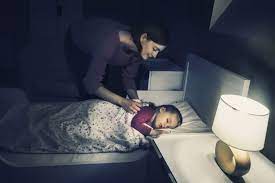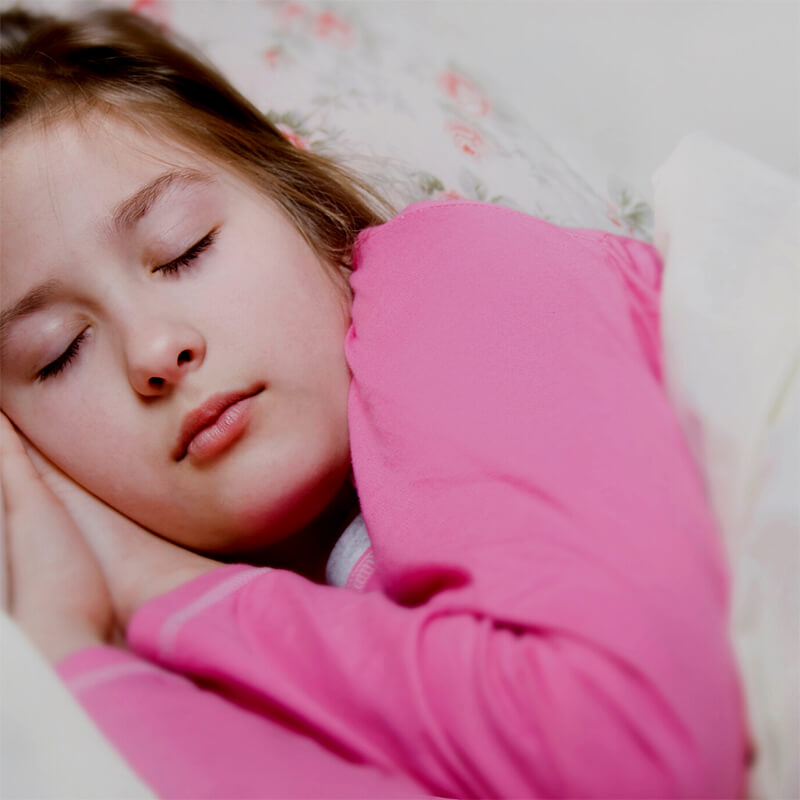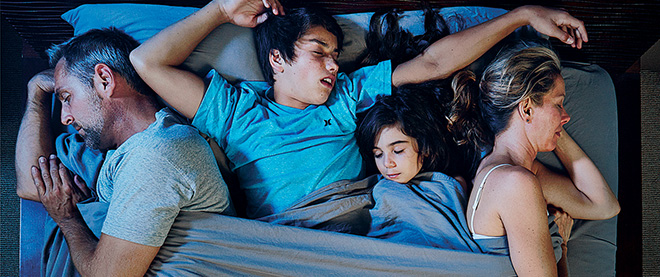Eleanor Jones (Clinical Psychologist Registrar)
For some children, sleeping alone at night can be a scary prospect. This can often lead to parents finding themselves co-sleeping with their children or having children frequently jumping into the parent’s bed in the middle of the night. This may be the case for toddlers through to teenagers.
Although we all need extra closeness sometimes, especially after a nightmare or if something stressful has happened during the day, ongoing difficulties with separating from parents at night can impact on both parent’s and children’s sleep and wellbeing in the long-term.
Co-sleeping is common, especially for children who experience anxiety, with research suggesting that more than 1 in 3 anxious children co-sleep at least sometimes (2–4 times a week)1. This is also true for anxious teens.
While most children will overcome mild nighttime fears on their own, children who have significant and ongoing night-time fears can benefit from help with settling at night. When children have night-time fears, they can find it hard to fall asleep (especially if they are alone), stay asleep during the night, and get back to sleep without help. The anxiety and poor sleep can have an impact on the child and their family, with everyone feeling stressed and tired.
To help children manage their nighttime fears, parents often stay with their child until the child falls asleep. Over time, this can mean the child depends on their parent being with them to be able to fall asleep. Often, parents find that when these problems continue, it becomes easier to stay with their child all night, or having the child co-sleep with parents, rather than having the constant up-and-down when the child wakes during the night. But, this can leave the family feeling stuck and unsure what to do to help the child sleep on their own again.
But, there are ways to help your child manage their nighttime fears and re-learn how to sleep by themselves. Here are some suggestions that may help your family. The suggestions below are for setting up a healthy sleep routine.
Involve your child in making a plan
Especially for older children (around age 6+), engage them in the process. What will be good about sleeping alone for them? This might include sleepovers with friends, having friends to sleep at theirs, being able to comfortably go on school camp. Also, see ‘Rewards’ below. The emphasis is on learning to be comfortable on my own at night https://snoozeforkids.com/ and less about falling asleep alone. If we are comfortable on our own, sleep will come. Ideally, we are working with our children, not working “on” them.

Build strong sleep habits
Having a consistent and appropriate sleep schedule can help children fall asleep more quickly and easily, as this helps to reinforce their biological sleep-wake rhythm (their body clock). In the evening, having a consistent bedtime routine that includes soothing activities (such as taking a bath, putting on pyjamas, and reading a story) and lasts 20-45 minutes can help to relax your child before bed, which can improve bedtime difficulties and decrease how often they wake during the night.
Go to bed drowsy
An important part of shifting from your child needing you with them to sleep, to being able to self-soothe and fall asleep by themselves, is to put them to bed when they are “drowsy but awake.” This will help your child develop self-soothing skills, which they can then use during the night if they wake before morning. Putting children to bed too early, before they are biologically sleepy may backfire as they may be more likely to become anxious if they are lying awake in bed for a longer period.

Take it step by step
Once your child is going to bed drowsy, rather than camping in with your child, the next step is saying goodnight and leaving your child alone for 5 minutes. On your return, quickly congratulate them for staying quietly in bed, and let them know you will be back to check on them soon. Each time you wait progressively longer periods of time before checking on your child (5 mins, 10 mins, 15 mins). We find that usually parents feel comfortable increasing the length of time by about 5 minute increments, but there is no “optimal” time between checking – see what works best for you and your child. The key for this is allowing your child to be more used to being alone at night and fall asleep by themselves, which helps them develop self-soothing skills. It is important to keep the checks brief and neutral – for example, to come in and verbally reassure your child, and give them a pat on the shoulder.
Good morning light
You might find yourself bringing your child into your bed in the early hours of the morning, such as once it is 5am. If this is disruptive for you, to change this, you can try a “good morning light.” This involves attaching a nightlight to a timer that is set to a reasonable time in the morning (e.g., 6am), and letting your child know that they may only get out of bed and come to your room once the good morning light turns on. You can also buy clocks with this function built-in, such as this option from Kmart.
Consistency and Motivation
These approaches are most successful when done consistently. So, consider what problems may arise and what you may do to handle these, in advance. As well, keep in mind that the first few nights of doing this will be difficult! When children realise you are not responding in the way they expect, they usually try even harder to get that response (for you to stay in bed with them) back again. See if you can stick with it, because most families start to see positive changes after 3 to 7 days.
Use rewards
Set up a system with your child to help reinforce positive changes in their behaviour at night, such as a sticker reward chart, or the child getting to select the family meal or a game to play the following day. Rewards are most effective if they are given immediately – so, have your child put the sticker on the chart first thing the next morning. Rewards also work best if the child experiences success, so try and set achievable goals, rather than reaching for the stars. With time, you can set more challenging goals, and reduce how frequently your child gets a reward (for example, needing five stickers in a week to get a reward, instead of only three).
Psychological therapy to help manage anxiety and sleep difficulties
You may need some extra support in designing and implementing some of these strategies, especially if there are many sleep problems or they have lasted for a long time. Or, your child may also experience anxiety about many areas, and not only at night, and so they need some extra help with managing these worries. Or, you might have tried these approaches yourself already, but not had as much success as you would like. An appropriate therapist can help to identify any roadblocks and work with you to help put a new and improved plan in place to help your family.
See your GP, paediatrician, or us at Sleep Matters if you need support with managing difficulties with your child sleeping alone at night.
Or try this Self Help resource: Snooze for Kids https://snoozeforkids.com/

References
Blunden, S. L. (2012). Behavioural sleep disorders across the developmental age span: an overview of causes, consequences and treatment modalities. Psychology, 3(03), 249.
Mindell, J. A., & Owens, J. A. (2015). A clinical guide to pediatric sleep: diagnosis and management of sleep problems. Lippincott Williams & Wilkins.
Palmer, C. A., Clementi, M. A., Meers, J. M., & Alfano, C. A. (2018). Co-sleeping among school-aged anxious and non-anxious children: associations with sleep variability and timing. Journal of abnormal child psychology

